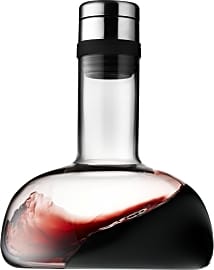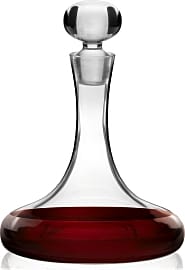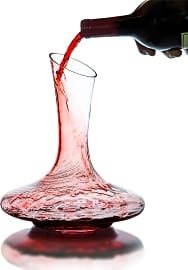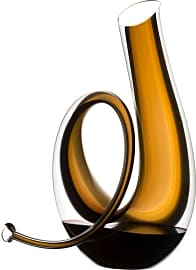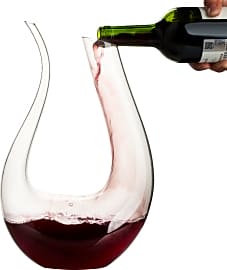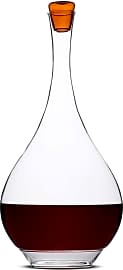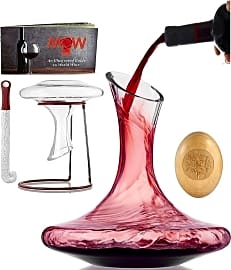The 10 Best Wine Decanters

This wiki has been updated 40 times since it was first published in April of 2015. A decanter can quickly and easily enhance the bouquet and flavor of any bottle of wine, whether it's a grocery store bargain or an expensive vintage, by allowing it to breathe. More than simply pitchers, the selections we've picked out will also add to the aesthetic appeal of any dinner party or quiet evening in. We have ranked them by durability, aeration abilities, and style. When users buy our independently chosen editorial recommendations, we may earn commissions to help fund the Wiki.
Editor's Notes
April 30, 2020:
Before picking out a decanter, I always like to think about when and where I plan to use it. Something without curls or without what I'll call break points or aeration points will have little other than the act of pouring and whatever surface area its can create at its widest level to let the wine breathe. I find these models, like the Krosno Handmade Holden or the Le Chateau are ideal if you know you have company coming over, especially if they aren't big drinkers. You can pour the wine early and give it the time it needs to breathe.
If you're the type to host impromptu gatherings, or you plan on going through several bottles in one sitting, it'd be wise to invest in something that either comes with a dedicated aerator top like the Menu Carafe or something that at least has one of those curls or aeration points in it over which your wine pours. These help to gently agitate the wine and increase its exposure to the air, not unlike the way whipping eggs can make them fluffier (wine, of course, lacks the fat and protein structures necessary to contain large air bubbles the way eggs do). And while our main list contains plenty of curled options like the WBSEos Classic Aerator or the Riedel 2014/02 Horn, it lacks models with break points, which is where you'll have to look to the Lemi Luxury on our special honors list.
Special Honors
Lemi Luxury The conical shape of this model actually contains another, smaller cone within. When you insert a bottle through the hole in its side, you'll pour your spirits over the tip of this interior cone, allowing it to break over its pointed tip and increasing the intensity of the aeration. It's a striking option that's as effective as it is attractive. lemidecor.com
Asprey Connoisseur With its sterling silver handle and pouring spout, you'll definitely want to reserve this model for the finest vintages in your collection. It's designed to hold a 750-milliliter bottle with plenty of room for oxygenation, and it — like all the company's fine crafts — is handmade in a small London workshop. asprey.com
Wine Not?
The decanter is almost exclusively used for red wines served at room temperature.
The wine decanter has existed on Earth for thousands of years to achieve one purpose: make wine better. The decanter's mission is to aerate the wine, which enhances it by releasing its aroma and flavor. The decanter also doubles as a serving vessel with an impressive presentation. Finally, it separates sediment that is commonly found in older, tannic red wines. Aged Bordeaux wines, for instance, would hugely benefit from decantation.
Whether the wine decanter is essential for a consumer is a matter of your wine drinking habits. The decanter is almost exclusively used for red wines served at room temperature. If you are a creature of habit who imbibes solely on white wines, the decanter might not be for you. As seen on our list, white wines are rarely decanted. Buying one without using it for red wines would be a waste.
Here is the science behind the magic that is the decanter. The wine is poured into the decanter that has a large base. The wide shape is intentional; to cultivate a wider surface area for the wine to get oxygen. That explains the unique shape of decanters. The small controlled amount of oxygen that gets into the wine can help release the tightness, and open up the bouquet and aromas, but prolonged exposure will turn a robust wine stale and flat. The decanter is not a storage vessel, meaning wine decanted should be consumed in one sitting. This is especially beneficial for Cabernet Sauvignon and Syrah, which are more delicate.
The poor man's version of decanting a wine is simply swirling it in your glass, which some will argue has the same effect as a decanter. Others will argue that this is safer; decanting the whole bottle will add too much oxygen, thus ruining the precious ambrosia.
Function Versus Form
Although the purpose and design are both simple, the wine decanter can boast some variety. The vessel itself is usually made from glass or crystal to show off the beautiful dark red color of wine.
While the material is clearly for aesthetics, you should remember that clear glass will not protect the wine from harsh light which can destroy flavor profiles. Do not expose your decanted wine to sunlight or strong overhead light fixtures. This is also the reason that red wines come in dark green bottles; it protects the liquid from UV rays.
Do not expose your decanted wine to sunlight or strong overhead light fixtures.
The base is more stable than a bottle of wine, and less prone to be knocked over in the heat of the festivities. The vessel is usually large enough to hold the contents of a standard bottle of wine; 750ml. The wide base is designed to expose the surface area to oxygen, as previously discussed. The more oxygen that gets exposed, the less time needed for the wine to decant. The moral of the story is that you get to drink delicious wine faster!
The largest disparity in price of the decanter will be determined by the design. The duck decanter which is number three on our list, for instance, is at least five times the cost than its counterparts with no improvement of functionality. If in a pinch, you can decant in a mason jar if you so choose. The design aspect is part of the allure of wine culture, and presentational skills.
A stopper may be included to close off oxygen from the decanter. This is useful for storage, or other liquors such as expensive whiskeys which can benefit from decantation. However, unlike liquor, it is recommended to consume the wine decanted in the same sitting. The freshness of wine subsides very shortly; stopper or not.
A Brief History of the Wine Decanter
The vast history of wine consumption goes hand in hand with serving the wine. Since Roman antiquity, servants used a decanter to easily pour and serve their wealthy patrons and guests. The Romans were also the first to pioneer glass for the vessel. As the Roman Empire fell, so did glass, and due to its scarcity lead and bronze replaced glass as the primary material.
That being said, the decanter tends to be a wedding gift favorite, so you most likely will encounter one at your next nuptial function.
A thousand years later, the Renaissance introduced the glass decanter once again. This also made it easier to see what was in the wine, and the wine produced hundreds of years ago consisted of much more sediment than today's wine.
As winemaking has improved in recent years, many argue the need for a decanter is not justified. Less wines today will produce a large amount of sediment, thus eliminating the need for this luxury item.
That being said, the decanter tends to be a wedding gift favorite, so you most likely will encounter one at your next nuptial function. As a simple rule of thumb: decant old wines for air and sediment, young wines for presentation.



